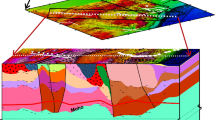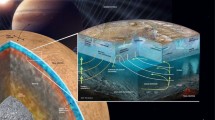Abstract
Two long seismic refraction lines along the crest of the Iceland-Faeroe Ridge reveal a layered crust resembling the crust beneath Iceland but differing from normal continental or oceanic crust. The Moho was recognised at the south-eastern end of the lines at an apparent depth of 16–18 km. A refraction line in deeper water west of the ridge and south of Iceland indicates a thin oceanic type crust underlain by a 7.1 km/s layer which may be anomalous upper mantle.
An extensive gravity survey of the ridge shows that it is in approximate isostatic equilibrium; the steep gravity gradient between the Norwegian Sea and the ridge indicates that the ridge is supported by a crust thickened to about 20 km rather than by anomalous low density rocks in the underlying upper mantle, in agreement with the seismic results. An increase in Bouguer anomaly of about 140 mgal between the centre of Iceland and the ridge is attributed to lateral variation in upper mantle density from an anomalous low value beneath Iceland to a more normal value beneath the ridge. Local gravity anomalies of medium amplitude which are characteristic of the ridge are caused by sediment troughs and by lateral variations in the upper crust beneath the sediments. A steep drop in Bouguer anomaly of about 80 mgal between the ridge and the Faeroe block is attributed partly to lateral change in crustal density and partly to slight thickening of the crust towards the Faeroe Islands; this crustal boundary may represent an anomalous type of continental margin formed when Greenland started to separate from the Faeroe Islands about 60 million years ago.
We conclude that the Iceland-Faeroe Ridge formed during ocean floor spreading by an anomalous ‘hot spot’ type of differentiation from the upper mantle such as is still active beneath Iceland. This suggests that the ridge may have stood some 2 km higher than at present when it was being formed in the early Tertiary, and that it has subsequently subsided as the spreading centre moved away and the underlying mantle became more normal; this interpretation is supported by recognition of a V-shaped sediment filled trough across the south-eastern end of the ridge, which may be a swamped sub-aerial valley.
Similar content being viewed by others
References
AveryO. E., BurtonG. D., and HeirtzlerJ. R.: 1968, ‘An Aeromagnetic Survey of the Norwegian Sea’, J. Geophys. Res., 73, 4583–600.
AveryO. E., VogtP. R., and HiggsR. H.: 1969, ‘Morphology, Magnetic Anomalies and Evolution of the Northeast Atlantic and Labrador Sea-Part II-Magnetic Anomalies’ (Abstract), Trans. Am. Geophys. Union 50, 184.
BancroftA. M.: 1960, ‘Gravity Anomalies over a Buried Step’, J. Geophys. Res., 65, 1630–1.
BåthM.: 1960, ‘Crustal Structure of Iceland’, J. Geophys. Res. 65, 1793–807.
BottM. H. P.: 1962, ‘A Simple Criterion for Interpreting Negative Gravity Anomalies’, Geophys. 27, 376–81.
BottM. H. P.: 1965a, ‘The Upper Mantle Beneath Iceland’, Geophys. J. Roy. Astron. Soc. 9, 275–7.
BottM. H. P.: 1965b, ‘Formation of Oceanic Ridges’, Nature 207, 840–3.
Bott, M. H. P. and Watts, A. B.: 1971, ‘Deep Structure of the Continental Margin Adjacent to the British Isles’, Rep. No. 70/14, Inst. Geol. Sci., 93–109.
BullardSir Edward, EverettJ. E., and SmithA. G.: 1965, ‘The Fit of the Continents Around the Atlantic’, Phil. Trans. Roy. Soc. 258A, 41–51.
EinarssonT.: 1954, ‘A Survey of Gravity in Iceland’, Soc. Sci. Islandica 30, 1–22.
EwingJ. and EwingM.: 1959, ‘Seismic-Refraction Measurements in the Atlantic Ocean Basins, in the Mediterranean Sea, on the Mid-Atlantic Ridge, and in the Norwegian Sea’, Bull. Geol. Soc. Am. 70, 291–318.
FrancisT. J. G.: 1969, ‘Upper Mantle Structure Along the Axis of the Mid-Atlantic Ridge near Iceland’, Geophys. J. Roy. Astron. Soc. 17, 507–20.
FleischerU. 1971, ‘Gravity Surveys over the Reykjanes Ridge and Between Iceland and the Faeroe Islands’, Marine Geophys. Res. 1, 314 (this issue).
GodbyE. A., HoodP. J., and BowerM. E.: 1968, ‘Aeromagnetic Profiles Across the Reykjanes Ridge Southwest of Iceland’, J. Geophys. Res. 73, 7637–49.
HeirtzlerJ. R., DicksonG. O., HerronE. M., PitmanW. C. III, and LePichonX.: 1968, ‘Marine Magnetic Anomalies, Geomagnetic Field Reversals, and Motions of the Ocean Floor and Continents’, J. Geophys. Res. 73, 2119–36.
Johnson, G. L. and Tanner, B.: 1971, ‘Geophysical Observations on the Iceland-Faeroe Ridge’, Jokull., in press.
JonesE. J. W., EwingM., EwingJ. I., and EittreimS. L.: 1970, ‘Influences of Norwegian Sea Overflow Water on Sedimentation in the Northern North Atlantic and Labrador Sea’, J. Geophys. Res. 75, 1655–80.
LongR. E. and MitchellM. G.: 1970, ‘Teleseismic P Wave Delay Time in Iceland’, Geophys. J. Roy. Astron. Soc. 20, 41–8.
MoorbathS., SigurdssonH., and GoodwinR.: 1968, ‘K-Ar Ages of the Oldest Exposed Rocks in Iceland’, Earth Planetary Sci. Letters 4, 197–205.
Noe-NygaardA.: 1962, ‘The Geology of the Faroes’, Quart. J. Geol. Soc. London 118, 375–83.
PálmasonG.: 1965, ‘Seismic Refraction Measurements of the Basalt Lavas of the Faeroe Islands’, Tectonophysics 2, 475–82.
PálmasonG.: 1965, ‘Upper Crustal Structure in Iceland’, Soc. Sci. Islandica 38, 67–78.
Pálmason, G.: 1970, Crustal Structure of Iceland from Explosion Seismology, Science Institute, University of Iceland, 239 pp.
Saxov, S.: 1969, ‘Gravimetry in the Faroe Islands’, Geodæ. Inst., Medd. 43, Copenhagen, 24 pp.
SmithR. A.: 1959, ‘Some Depth Formulae for Local Magnetic and Gravity Anomalies’, Geophys. Prosp. 7, 55–63.
TarlingD. H. and GaleN. H.: 1968, ‘Isotopic Dating and Palaeomagnetic Polarity in the Faeroe Islands’, Nature 218, 1043–4.
TryggvasonE.: 1962, ‘Crustal Structure of the Iceland Region from Dispersion of Surface Waves’, Bull. Seism. Soc. Am. 52, 359–88.
TryggvasonE.: 1964, ‘Arrival Times of P Waves and Upper Mantle Structure’, Bull. Seism. Soc. Am. 54, 727–36.
VogtP. R., OstensoN. A. and JohnsonG. L.: 1970, ‘Magnetic and Bathymetric Data Bearing on Sea-Floor Spreading North of Iceland’, J. Geophys. Res. 75, 536–8.
WilsonJ. T.: 1963, ‘Evidence from Islands on the Spreading of Ocean Floors’, Nature 197, 536–8.
Author information
Authors and Affiliations
Rights and permissions
About this article
Cite this article
Bott, M.H.P., Browitt, C.W.A. & Stacey, A.P. The deep structure of the Iceland-Faeroe Ridge. Marine Geophysical Researches 1, 328–351 (1971). https://doi.org/10.1007/BF00338261
Received:
Issue Date:
DOI: https://doi.org/10.1007/BF00338261




